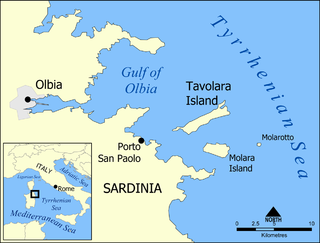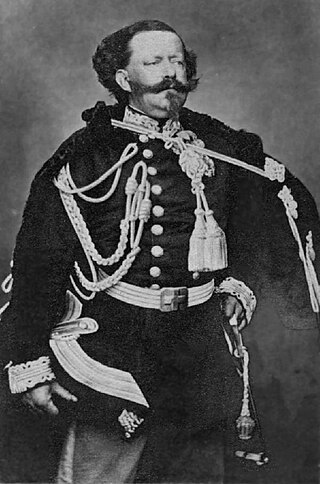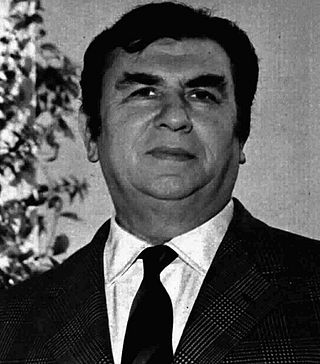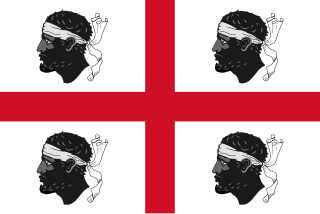
Tavolara is a small island off the northeast coast of Sardinia, Italy. The island is a limestone massif 5 kilometres long and 1 kilometre wide, with steep cliffs except at its ends. Its highest point, Monte Cannone, is 565 metres above sea level. A cove and beach can be found at each end of the island, Spalmatore di Fuori at the northeast, and Spalmatore di Terra at the southwest. Currently, the island is inhabited by only a handful of families, and has a small cemetery and summer restaurant. The water around the island is a popular spot for scuba diving.

Archaeological evidence of prehistoric human settlement on the island of Sardinia is present in the form of nuraghes and other prehistoric monuments, which dot the land. The recorded history of Sardinia begins with its contacts with the various people who sought to dominate western Mediterranean trade in classical antiquity: Phoenicians, Punics and Romans. Initially under the political and economic alliance with the Phoenician cities, it was partly conquered by Carthage in the late 6th century BC and then entirely by Rome after the First Punic War. The island was included for centuries in the Roman province of Sardinia and Corsica, which would be incorporated into the diocese of Italia suburbicaria in 3rd and 7th centuries.

Bertoleoni is the proclaimed ruling family of the styled "Kingdom of Tavolara", which claimed to be "the smallest kingdom of the world". The members of this family were also the only inhabitants of this island that had been abandoned in 1962. The island was claimed by Italy, however, it was never officially annexed and therefore this does not abolish any prior royal titles. The people of the island sustained themselves by goat farming and fishing. Currently, the supposed kingdom is a tourist attraction for the 57 or so native inhabitants of the island, where the current king and crown princess run its two restaurants and sell souvenirs to visitors of the Natural Park. The family has more influence over the island than anyone else.

Victor Emmanuel II was King of Sardinia from 23 March 1849 until 17 March 1861, when he assumed the title of King of Italy and became the first king of an independent, united Italy since the 6th century, a title he held until his death in 1878. Borrowing from the old Latin title Pater Patriae of the Roman emperors, the Italians gave him the epithet of Father of the Fatherland.

The Republic of Rose Island was a short-lived micronation on a man-made platform in the Adriatic Sea, 11 kilometres (6.8 mi) off the coast of the province of Rimini, Italy, built by Italian engineer Giorgio Rosa, who made himself its president and declared it an independent state on 1 May 1968. Rose Island had its own government, currency, post office, and commercial establishments, and the official language was Esperanto.

Alessandro "Sandro" Pertini was an Italian socialist politician who served as the president of Italy from 1978 to 1985.

Luigi Cervi, better known as Gino Cervi, was an Italian actor. He was best known for portraying Peppone in a series of comedies based on the character Don Camillo (1952–1965), and police detective Jules Maigret on the television series Le inchieste del commissario Maigret (1964–1972).

The Strega Prize is the most prestigious Italian literary award. It has been awarded annually since 1947 for the best work of prose fiction written in the Italian language by an author of any nationality and first published between 1 May of the previous year and 30 April.

The Order of Saints Maurice and Lazarus is a Roman Catholic dynastic order of knighthood bestowed by the royal House of Savoy. It is the second-oldest order of knighthood in the world, tracing its lineage to AD 1098, and it is one of the rare orders of knighthood recognized by papal bull, in this case by Pope Gregory XIII. In that bull, Pope Gregory XIII bestowed upon Emmanuel Philibert, Duke of Savoy and his Savoy successors, the right to confer this knighthood in perpetuity. The Grand Master is, Vittorio Emanuele, Prince of Naples, also known as the Duke of Savoy, the eldest son of the last King of Italy, Umberto II of Italy. However Vittorio Emanuele's cousin once removed Prince Aimone, Duke of Aosta claims to be grand master as his father claimed to be head of the house of Savoy.

The Kingdom of Sardinia, also referred to as the Kingdom ofSardinia-Piedmont or Piedmont-Sardinia as a composite state during the Savoyard period, was a country in Southern Europe from the late 13th until the mid 19th century.

Sardinian nationalism or also Sardism is a social, cultural and political movement in Sardinia calling for the self-determination of the Sardinian people in a context of national devolution, further autonomy in Italy, or even outright independence from the latter. It also promotes the protection of the island's environment and the preservation of its cultural heritage.
The Moderate Party, collectively called Moderates, was an Italian pre-Unification political rally, active during the Risorgimento (1815–1861). The Moderates were never a formal party, but only a movement of liberal-minded reformist patriots, usually secular, from politics, military, literature and philosophy.
This is a list of Italian television related events of 1975.













